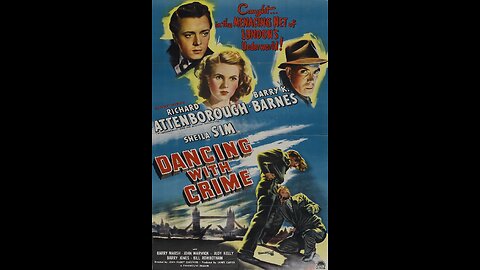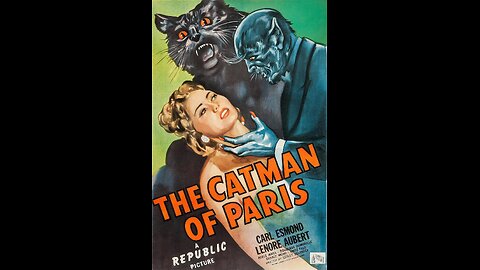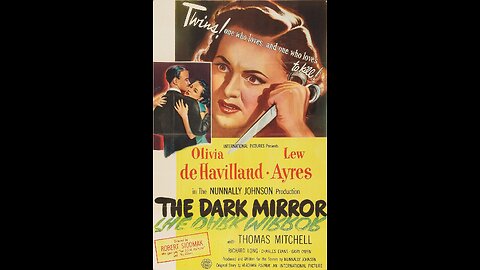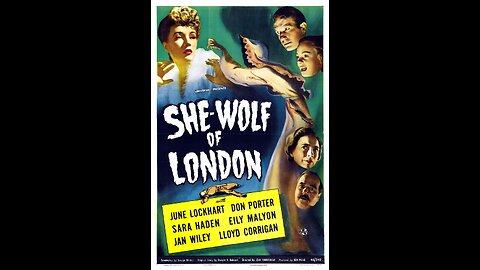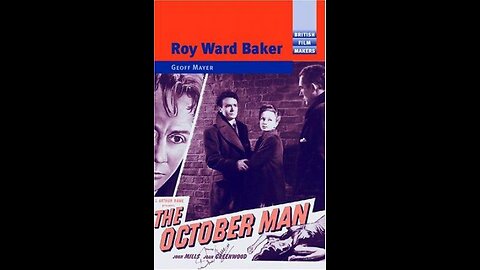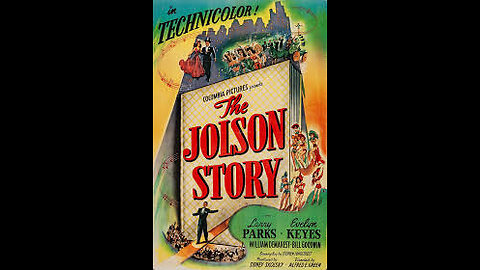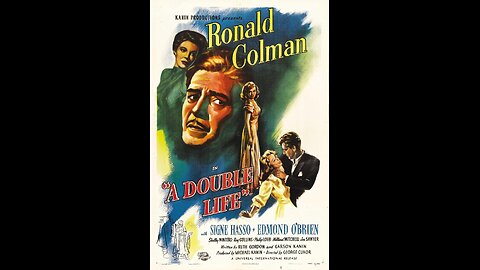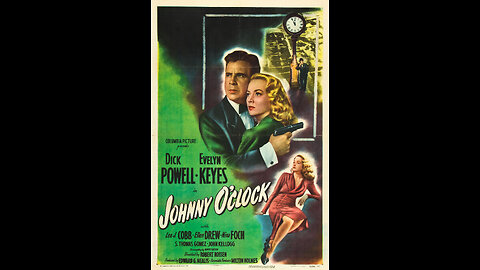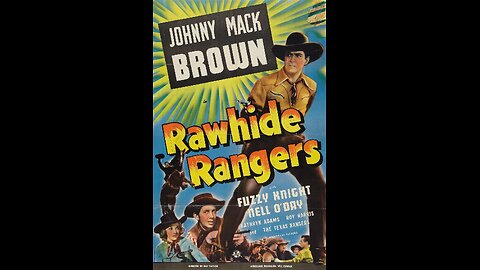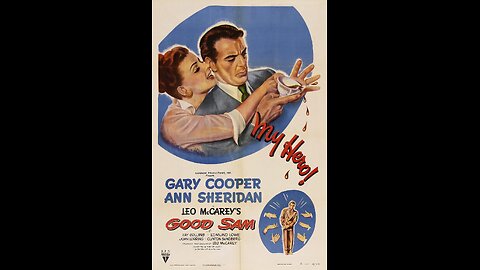
1940-1949 Movies
445 videos
Updated 27 minutes ago
The Best of Anglo American Films from 1940-1949
-
Good Sam (1948) | Directed by Leo McCarey
 Classic Films & Movies ArchiveGood Sam is a romantic comedy-drama that centers on Sam Clayton, a kind-hearted department store manager who can't resist helping others, often at the expense of his own family's well-being. His unwavering generosity leads to a series of humorous and challenging situations, testing the patience of his wife, Lu, and prompting reflections on the balance between altruism and personal responsibility. Genre: Romantic Comedy-Drama Director: Leo McCarey Leo McCarey was an American film director, screenwriter, and producer renowned for his work in both comedy and drama. Born in 1898, he directed classics such as "Duck Soup" (1933) with the Marx Brothers and "The Awful Truth" (1937), which earned him an Academy Award for Best Director. McCarey's films often explored themes of human kindness and moral dilemmas, blending humor with heartfelt storytelling. Star Cast: - Gary Cooper as Sam Clayton - Ann Sheridan as Lu Clayton - Ray Collins as Reverend Daniels - Edmund Lowe as H.C. Borden - Joan Lorring as Shirley Mae Upon its release, "Good Sam" received mixed reviews. Some critics appreciated the film's exploration of altruism and Gary Cooper's portrayal of the benevolent protagonist. However, others felt the narrative was overly sentimental and lacked the sharpness of McCarey's earlier works. Despite the divided opinions, the film was among the higher-grossing movies of 1948, indicating a favorable audience reception. Fun Facts: - Director Leo McCarey shot two different endings for the film and used audience feedback from preview screenings to decide which one to use. - During production, Gary Cooper was called to testify before the House Un-American Activities Committee in October 1947, temporarily halting filming. - The film's original runtime was 130 minutes but was later edited down to 114 minutes for its reissue. - Ann Sheridan was loaned from Warner Bros. to play the role of Lu Clayton, showcasing her versatility beyond her typical "sassy" character portrayals. * This Rumble Movie Channel is comprehensively indexed on https://kinoquick.com - find you favourite movies fast & free! Subscribe to this channel to be notified of daily movie updates.8 views
Classic Films & Movies ArchiveGood Sam is a romantic comedy-drama that centers on Sam Clayton, a kind-hearted department store manager who can't resist helping others, often at the expense of his own family's well-being. His unwavering generosity leads to a series of humorous and challenging situations, testing the patience of his wife, Lu, and prompting reflections on the balance between altruism and personal responsibility. Genre: Romantic Comedy-Drama Director: Leo McCarey Leo McCarey was an American film director, screenwriter, and producer renowned for his work in both comedy and drama. Born in 1898, he directed classics such as "Duck Soup" (1933) with the Marx Brothers and "The Awful Truth" (1937), which earned him an Academy Award for Best Director. McCarey's films often explored themes of human kindness and moral dilemmas, blending humor with heartfelt storytelling. Star Cast: - Gary Cooper as Sam Clayton - Ann Sheridan as Lu Clayton - Ray Collins as Reverend Daniels - Edmund Lowe as H.C. Borden - Joan Lorring as Shirley Mae Upon its release, "Good Sam" received mixed reviews. Some critics appreciated the film's exploration of altruism and Gary Cooper's portrayal of the benevolent protagonist. However, others felt the narrative was overly sentimental and lacked the sharpness of McCarey's earlier works. Despite the divided opinions, the film was among the higher-grossing movies of 1948, indicating a favorable audience reception. Fun Facts: - Director Leo McCarey shot two different endings for the film and used audience feedback from preview screenings to decide which one to use. - During production, Gary Cooper was called to testify before the House Un-American Activities Committee in October 1947, temporarily halting filming. - The film's original runtime was 130 minutes but was later edited down to 114 minutes for its reissue. - Ann Sheridan was loaned from Warner Bros. to play the role of Lu Clayton, showcasing her versatility beyond her typical "sassy" character portrayals. * This Rumble Movie Channel is comprehensively indexed on https://kinoquick.com - find you favourite movies fast & free! Subscribe to this channel to be notified of daily movie updates.8 views -
Dancing with Crime (1947) | Directed by John Paddy Carstairs
 Classic Films & Movies ArchiveDancing with Crime is a British crime thriller that follows Ted Peters, a London taxi driver, who becomes entangled in the criminal underworld after his childhood friend and fellow ex-serviceman, Dave Robinson, is murdered. Determined to uncover the truth, Ted, with the help of his fiancée Joy Goodall, investigates a dance hall that serves as a front for black-market activities. As they delve deeper, they confront dangerous criminals, risking their lives to bring justice to Dave's killers. Genre: Crime, Thriller, Film Noir Director: John Paddy Carstairs John Paddy Carstairs was a British film director, screenwriter, novelist, and painter. Born in 1910, he directed numerous films from the 1930s to the 1960s, spanning various genres including comedies, dramas, and thrillers. Carstairs is perhaps best known for directing several films in the "Doctor" series, such as "Doctor in the House" (1954). His versatility and prolific output made him a notable figure in mid-20th-century British cinema. Star Cast: - Richard Attenborough as Ted Peters - Sheila Sim as Joy Goodall - Barry K. Barnes as Paul Baker - Garry Marsh as Detective Sergeant Murray - Barry Jones as Mr. Gregory - Bill Owen as Dave Robinson - Judy Kelly as Toni Masters Upon its release, "Dancing with Crime" received positive reviews for its engaging narrative and strong performances. Richard Attenborough's portrayal of Ted Peters was particularly lauded, showcasing his ability to embody earnest and determined characters. The film's depiction of post-war London's seedy underbelly resonated with audiences, offering a gritty and realistic crime story. Over time, it has been recognized as a noteworthy example of British film noir. Fun Facts: - Richard Attenborough and Sheila Sim, who played the lead roles, were married in real life; this film marked their first on-screen appearance together. - The film features an early uncredited appearance by Dirk Bogarde as a police radio caller, who would later become a prominent British actor. - Filming took place at Southall Studios in London, with some scenes shot on location, providing authentic London backdrops. - The film's budget was approximately £200,000, a modest sum that was typical for British productions of that era. - "Dancing with Crime" is noted for its atmospheric portrayal of London's dance halls, which were popular venues in post-war Britain and often depicted in cinema as hotspots for illicit activities. * This Rumble Movie Channel is comprehensively indexed on https://kinoquick.com - find you favourite movies fast & free! Subscribe to this channel to be notified of daily movie updates.80 views
Classic Films & Movies ArchiveDancing with Crime is a British crime thriller that follows Ted Peters, a London taxi driver, who becomes entangled in the criminal underworld after his childhood friend and fellow ex-serviceman, Dave Robinson, is murdered. Determined to uncover the truth, Ted, with the help of his fiancée Joy Goodall, investigates a dance hall that serves as a front for black-market activities. As they delve deeper, they confront dangerous criminals, risking their lives to bring justice to Dave's killers. Genre: Crime, Thriller, Film Noir Director: John Paddy Carstairs John Paddy Carstairs was a British film director, screenwriter, novelist, and painter. Born in 1910, he directed numerous films from the 1930s to the 1960s, spanning various genres including comedies, dramas, and thrillers. Carstairs is perhaps best known for directing several films in the "Doctor" series, such as "Doctor in the House" (1954). His versatility and prolific output made him a notable figure in mid-20th-century British cinema. Star Cast: - Richard Attenborough as Ted Peters - Sheila Sim as Joy Goodall - Barry K. Barnes as Paul Baker - Garry Marsh as Detective Sergeant Murray - Barry Jones as Mr. Gregory - Bill Owen as Dave Robinson - Judy Kelly as Toni Masters Upon its release, "Dancing with Crime" received positive reviews for its engaging narrative and strong performances. Richard Attenborough's portrayal of Ted Peters was particularly lauded, showcasing his ability to embody earnest and determined characters. The film's depiction of post-war London's seedy underbelly resonated with audiences, offering a gritty and realistic crime story. Over time, it has been recognized as a noteworthy example of British film noir. Fun Facts: - Richard Attenborough and Sheila Sim, who played the lead roles, were married in real life; this film marked their first on-screen appearance together. - The film features an early uncredited appearance by Dirk Bogarde as a police radio caller, who would later become a prominent British actor. - Filming took place at Southall Studios in London, with some scenes shot on location, providing authentic London backdrops. - The film's budget was approximately £200,000, a modest sum that was typical for British productions of that era. - "Dancing with Crime" is noted for its atmospheric portrayal of London's dance halls, which were popular venues in post-war Britain and often depicted in cinema as hotspots for illicit activities. * This Rumble Movie Channel is comprehensively indexed on https://kinoquick.com - find you favourite movies fast & free! Subscribe to this channel to be notified of daily movie updates.80 views -
The Catman of Paris (1946) | Directed by Lesley Selander
 Classic Films & Movies ArchiveThe Catman of Paris is a mystery-horror film set in 19th-century Paris. The story follows Charles Regnier, a successful author whose latest book has angered government officials. Upon his return to Paris, a series of gruesome murders occur, with victims clawed to death, leading to rumors of a feline-like killer. As suspicion falls on Regnier, he experiences blackouts and begins to question his own innocence. The film explores themes of identity, superstition, and the blurred lines between man and beast. Genre: Mystery, Horror Director: Lesley Selander Lesley Selander was an American film director known for his prolific work in the Western genre. Born in 1900, he directed over 100 films between the 1930s and 1960s. While Westerns were his primary focus, Selander occasionally ventured into other genres, including horror and adventure. His efficient directing style made him a reliable figure in Hollywood's B-movie industry. Star Cast: - Carl Esmond as Charles Regnier - Lenore Aubert as Marie Audet - Adele Mara as Marguerite Duval - Douglass Dumbrille as Henry Borchard - Gerald Mohr as Inspector Severen - Fritz Feld as Police Prefect Upon its release, The Catman of Paris received mixed reviews. Some audiences appreciated its atmospheric setting and the blend of mystery and horror elements. However, critics often pointed out the film's sluggish plot and lack of suspense. Over time, it has been viewed as a modest entry in Republic Pictures' catalog of 1940s horror films. Fun Facts: - The film was produced by Republic Pictures, known primarily for Westerns and serials, marking one of their few forays into the horror genre. - The production was completed in a short span, with filming starting on September 20 and concluding on October 10, 1945. - The Catman of Paris was intended to be part of a double feature alongside another horror film, Valley of the Zombies, as Republic Pictures' first horror double bill. - Despite its title, the film does not feature a traditional "catman" creature but rather centers on the psychological turmoil of the protagonist amid mysterious killings. * This Rumble Movie Channel is comprehensively indexed on https://kinoquick.com - find you favourite movies fast & free! Subscribe to this channel to be notified of daily movie updates.115 views
Classic Films & Movies ArchiveThe Catman of Paris is a mystery-horror film set in 19th-century Paris. The story follows Charles Regnier, a successful author whose latest book has angered government officials. Upon his return to Paris, a series of gruesome murders occur, with victims clawed to death, leading to rumors of a feline-like killer. As suspicion falls on Regnier, he experiences blackouts and begins to question his own innocence. The film explores themes of identity, superstition, and the blurred lines between man and beast. Genre: Mystery, Horror Director: Lesley Selander Lesley Selander was an American film director known for his prolific work in the Western genre. Born in 1900, he directed over 100 films between the 1930s and 1960s. While Westerns were his primary focus, Selander occasionally ventured into other genres, including horror and adventure. His efficient directing style made him a reliable figure in Hollywood's B-movie industry. Star Cast: - Carl Esmond as Charles Regnier - Lenore Aubert as Marie Audet - Adele Mara as Marguerite Duval - Douglass Dumbrille as Henry Borchard - Gerald Mohr as Inspector Severen - Fritz Feld as Police Prefect Upon its release, The Catman of Paris received mixed reviews. Some audiences appreciated its atmospheric setting and the blend of mystery and horror elements. However, critics often pointed out the film's sluggish plot and lack of suspense. Over time, it has been viewed as a modest entry in Republic Pictures' catalog of 1940s horror films. Fun Facts: - The film was produced by Republic Pictures, known primarily for Westerns and serials, marking one of their few forays into the horror genre. - The production was completed in a short span, with filming starting on September 20 and concluding on October 10, 1945. - The Catman of Paris was intended to be part of a double feature alongside another horror film, Valley of the Zombies, as Republic Pictures' first horror double bill. - Despite its title, the film does not feature a traditional "catman" creature but rather centers on the psychological turmoil of the protagonist amid mysterious killings. * This Rumble Movie Channel is comprehensively indexed on https://kinoquick.com - find you favourite movies fast & free! Subscribe to this channel to be notified of daily movie updates.115 views -
The Dark Mirror (1946) | Directed by Robert Siodmak
 Classic Films & Movies ArchiveThe Dark Mirror is a psychological thriller about twin sisters, one of whom is suspected of murder. When a man is found dead, witnesses identify one of the twin sisters, but the police quickly realize that both women look identical. As the investigation unfolds, a psychiatrist is brought in to analyze their personalities and determine which sister may be the murderer. The film explores themes of identity, deception, and the psychological complexities of twin dynamics. Genre: Film Noir, Psychological Thriller Director: Robert Siodmak Robert Siodmak was a German-American filmmaker best known for his work in film noir. Born in 1900 in Germany, he started his career in the German film industry before fleeing the rise of the Nazis and establishing himself in Hollywood. Siodmak became one of the leading directors of the noir movement, with films like The Killers (1946), Criss Cross (1949), and Phantom Lady (1944). His signature style often featured dramatic lighting, suspenseful storytelling, and psychologically complex characters. Star Cast: - Olivia de Havilland as Ruth Collins / Terry Collins - Lew Ayres as Dr. Scott Elliott - Thomas Mitchell as Lt. Stevenson - Richard Long as Rusty - Charles Evans as Dist. Atty. Girard The Dark Mirror received strong reviews for its gripping story and Olivia de Havilland’s performance, in which she convincingly portrayed both sisters with distinct personalities. Critics praised the film’s clever use of psychological tension and the way it built suspense around the mystery of which twin was guilty. The movie was nominated for an Academy Award for Best Original Story. Over time, it has been recognized as a classic of the psychological thriller and noir genres, particularly for its innovative special effects that allowed de Havilland to interact with herself on screen. Fun Facts: - Olivia de Havilland was already a major star at the time and took on the challenge of playing dual roles, which required meticulous editing and effects to make the twin interactions seamless. - The film was one of the first to explore the concept of dual personalities and psychiatric analysis in a thriller format. - Special camera techniques and body doubles were used to create realistic scenes of both sisters appearing together. - The film’s cinematography and lighting contributed to the eerie atmosphere, emphasizing the contrast between the two sisters’ personalities. - The screenplay was written by Nunnally Johnson, who later wrote and directed The Three Faces of Eve (1957), another psychological drama about multiple identities. * This Rumble Movie Channel is comprehensively indexed on https://kinoquick.com - find you favourite movies fast & free! Subscribe to this channel to be notified of daily movie updates.154 views
Classic Films & Movies ArchiveThe Dark Mirror is a psychological thriller about twin sisters, one of whom is suspected of murder. When a man is found dead, witnesses identify one of the twin sisters, but the police quickly realize that both women look identical. As the investigation unfolds, a psychiatrist is brought in to analyze their personalities and determine which sister may be the murderer. The film explores themes of identity, deception, and the psychological complexities of twin dynamics. Genre: Film Noir, Psychological Thriller Director: Robert Siodmak Robert Siodmak was a German-American filmmaker best known for his work in film noir. Born in 1900 in Germany, he started his career in the German film industry before fleeing the rise of the Nazis and establishing himself in Hollywood. Siodmak became one of the leading directors of the noir movement, with films like The Killers (1946), Criss Cross (1949), and Phantom Lady (1944). His signature style often featured dramatic lighting, suspenseful storytelling, and psychologically complex characters. Star Cast: - Olivia de Havilland as Ruth Collins / Terry Collins - Lew Ayres as Dr. Scott Elliott - Thomas Mitchell as Lt. Stevenson - Richard Long as Rusty - Charles Evans as Dist. Atty. Girard The Dark Mirror received strong reviews for its gripping story and Olivia de Havilland’s performance, in which she convincingly portrayed both sisters with distinct personalities. Critics praised the film’s clever use of psychological tension and the way it built suspense around the mystery of which twin was guilty. The movie was nominated for an Academy Award for Best Original Story. Over time, it has been recognized as a classic of the psychological thriller and noir genres, particularly for its innovative special effects that allowed de Havilland to interact with herself on screen. Fun Facts: - Olivia de Havilland was already a major star at the time and took on the challenge of playing dual roles, which required meticulous editing and effects to make the twin interactions seamless. - The film was one of the first to explore the concept of dual personalities and psychiatric analysis in a thriller format. - Special camera techniques and body doubles were used to create realistic scenes of both sisters appearing together. - The film’s cinematography and lighting contributed to the eerie atmosphere, emphasizing the contrast between the two sisters’ personalities. - The screenplay was written by Nunnally Johnson, who later wrote and directed The Three Faces of Eve (1957), another psychological drama about multiple identities. * This Rumble Movie Channel is comprehensively indexed on https://kinoquick.com - find you favourite movies fast & free! Subscribe to this channel to be notified of daily movie updates.154 views -
She-Wolf of London (1946) | Directed by Jean Yarbrough
 Classic Films & Movies ArchiveShe-Wolf of London is a psychological horror-mystery film that follows a young woman who fears she may be responsible for a series of gruesome murders. Phyllis Allenby, living in Victorian London, believes she is cursed by the legendary "Allenby Curse," which supposedly turns her into a murderous werewolf. As she experiences strange episodes and finds evidence of violent attacks near her home, paranoia and terror grip her. The film builds suspense as Phyllis questions her own sanity, leading to a shocking revelation about the true nature of the crimes. Genre: Horror, Mystery, Thriller Director: Jean Yarbrough Jean Yarbrough was an American film and television director known for his work in low-budget horror films, westerns, and comedies. Born in 1901, he directed numerous B-movies for Universal Pictures, including horror films such as House of Horrors (1946) and The Brute Man (1946). Later in his career, he transitioned to television, working on popular shows like The Abbott and Costello Show and The Adventures of Superman. Though not widely celebrated, he had a prolific career in genre film making. Star Cast: - June Lockhart as Phyllis Allenby - Don Porter as Barry Lanfield - Sara Haden as Martha Winthrop - Jan Wiley as Carol Winthrop - Eily Malyon as Hannah - Lloyd Corrigan as Detective Latham She-Wolf of London was met with mixed reviews upon its release. Some audiences were disappointed by the lack of supernatural horror, expecting a traditional werewolf film, only to discover that the story was more of a psychological thriller. However, critics appreciated its eerie atmosphere and strong performances, particularly from June Lockhart. Over time, the film has gained some recognition as a unique entry in Universal’s horror catalog, offering a different take on the werewolf mythos. Fun Facts: - Despite its title, the film does not actually feature a werewolf, making it an unusual entry in the werewolf film subgenre. - June Lockhart, best known for her later roles in Lassie and Lost in Space, plays the lead in one of her earliest major film performances. - The movie was produced as part of Universal’s B-horror films in the 1940s, which often had lower budgets but were still popular among horror fans. - The story draws inspiration from classic Gothic horror themes, such as family curses, psychological distress, and Victorian-era suspense. - The film was shot on a relatively small set, relying on fog and shadows to create its moody atmosphere. * This Rumble Movie Channel is comprehensively indexed on https://kinoquick.com - find you favourite movies fast & free! Subscribe to this channel to be notified of daily movie updates.163 views
Classic Films & Movies ArchiveShe-Wolf of London is a psychological horror-mystery film that follows a young woman who fears she may be responsible for a series of gruesome murders. Phyllis Allenby, living in Victorian London, believes she is cursed by the legendary "Allenby Curse," which supposedly turns her into a murderous werewolf. As she experiences strange episodes and finds evidence of violent attacks near her home, paranoia and terror grip her. The film builds suspense as Phyllis questions her own sanity, leading to a shocking revelation about the true nature of the crimes. Genre: Horror, Mystery, Thriller Director: Jean Yarbrough Jean Yarbrough was an American film and television director known for his work in low-budget horror films, westerns, and comedies. Born in 1901, he directed numerous B-movies for Universal Pictures, including horror films such as House of Horrors (1946) and The Brute Man (1946). Later in his career, he transitioned to television, working on popular shows like The Abbott and Costello Show and The Adventures of Superman. Though not widely celebrated, he had a prolific career in genre film making. Star Cast: - June Lockhart as Phyllis Allenby - Don Porter as Barry Lanfield - Sara Haden as Martha Winthrop - Jan Wiley as Carol Winthrop - Eily Malyon as Hannah - Lloyd Corrigan as Detective Latham She-Wolf of London was met with mixed reviews upon its release. Some audiences were disappointed by the lack of supernatural horror, expecting a traditional werewolf film, only to discover that the story was more of a psychological thriller. However, critics appreciated its eerie atmosphere and strong performances, particularly from June Lockhart. Over time, the film has gained some recognition as a unique entry in Universal’s horror catalog, offering a different take on the werewolf mythos. Fun Facts: - Despite its title, the film does not actually feature a werewolf, making it an unusual entry in the werewolf film subgenre. - June Lockhart, best known for her later roles in Lassie and Lost in Space, plays the lead in one of her earliest major film performances. - The movie was produced as part of Universal’s B-horror films in the 1940s, which often had lower budgets but were still popular among horror fans. - The story draws inspiration from classic Gothic horror themes, such as family curses, psychological distress, and Victorian-era suspense. - The film was shot on a relatively small set, relying on fog and shadows to create its moody atmosphere. * This Rumble Movie Channel is comprehensively indexed on https://kinoquick.com - find you favourite movies fast & free! Subscribe to this channel to be notified of daily movie updates.163 views -
October Man (1947) | Directed by Roy Ward Baker
 Classic Films & Movies ArchiveOctober Man is a British psychological thriller about a man recovering from a traumatic accident who becomes the prime suspect in a murder case. The film follows Jim Ackland, who struggles with psychological distress after surviving a bus crash that killed a young girl in his care. As he tries to rebuild his life, he is falsely accused of murdering a woman in his boarding house. Facing police scrutiny and public suspicion, he must prove his innocence while battling his own self-doubt. Genre: Thriller, Crime, Drama Director: Roy Ward Baker Roy Ward Baker was an English filmmaker known for his work in both British and Hollywood cinema. Born in 1916, he gained recognition for directing films across multiple genres, including thrillers, war dramas, and horror films. His most famous works include A Night to Remember (1958), which depicted the Titanic disaster, and several Hammer Horror productions. He was respected for his precise storytelling and ability to create suspenseful atmospheres. Star Cast: - John Mills as Jim Ackland - Joan Greenwood as Jenny Carden - Edward Chapman as Mr. Peachy - Kay Walsh as Molly Newman - Joyce Carey as Mrs. Vinton - Catherine Lacey as Miss Selby October Man received positive reviews for its gripping narrative and John Mills’ compelling performance as the troubled protagonist. Critics praised the film’s psychological depth and atmospheric tension, considering it a standout British thriller of the era. Audiences appreciated its intelligent script and suspenseful plot, which kept viewers guessing until the end. Though not as widely known today, it remains a well-regarded classic in British cinema. Fun Facts: - The screenplay was written by Eric Ambler, a renowned writer of spy and thriller novels. - John Mills, already a major star, was praised for his portrayal of a man suffering from psychological trauma, a theme not commonly explored in films of the time. - The film’s moody cinematography and use of shadows contribute to its noir-like atmosphere, despite being a British production rather than a Hollywood noir. - October Man was one of Roy Ward Baker’s early directorial efforts before he went on to greater fame with historical and horror films. - The film’s title refers to the protagonist’s emotional state rather than the time of year, symbolizing his loneliness and struggles with identity. * This Rumble Movie Channel is comprehensively indexed on https://kinoquick.com - find you favourite movies fast & free! Subscribe to this channel to be notified of daily movie updates.161 views
Classic Films & Movies ArchiveOctober Man is a British psychological thriller about a man recovering from a traumatic accident who becomes the prime suspect in a murder case. The film follows Jim Ackland, who struggles with psychological distress after surviving a bus crash that killed a young girl in his care. As he tries to rebuild his life, he is falsely accused of murdering a woman in his boarding house. Facing police scrutiny and public suspicion, he must prove his innocence while battling his own self-doubt. Genre: Thriller, Crime, Drama Director: Roy Ward Baker Roy Ward Baker was an English filmmaker known for his work in both British and Hollywood cinema. Born in 1916, he gained recognition for directing films across multiple genres, including thrillers, war dramas, and horror films. His most famous works include A Night to Remember (1958), which depicted the Titanic disaster, and several Hammer Horror productions. He was respected for his precise storytelling and ability to create suspenseful atmospheres. Star Cast: - John Mills as Jim Ackland - Joan Greenwood as Jenny Carden - Edward Chapman as Mr. Peachy - Kay Walsh as Molly Newman - Joyce Carey as Mrs. Vinton - Catherine Lacey as Miss Selby October Man received positive reviews for its gripping narrative and John Mills’ compelling performance as the troubled protagonist. Critics praised the film’s psychological depth and atmospheric tension, considering it a standout British thriller of the era. Audiences appreciated its intelligent script and suspenseful plot, which kept viewers guessing until the end. Though not as widely known today, it remains a well-regarded classic in British cinema. Fun Facts: - The screenplay was written by Eric Ambler, a renowned writer of spy and thriller novels. - John Mills, already a major star, was praised for his portrayal of a man suffering from psychological trauma, a theme not commonly explored in films of the time. - The film’s moody cinematography and use of shadows contribute to its noir-like atmosphere, despite being a British production rather than a Hollywood noir. - October Man was one of Roy Ward Baker’s early directorial efforts before he went on to greater fame with historical and horror films. - The film’s title refers to the protagonist’s emotional state rather than the time of year, symbolizing his loneliness and struggles with identity. * This Rumble Movie Channel is comprehensively indexed on https://kinoquick.com - find you favourite movies fast & free! Subscribe to this channel to be notified of daily movie updates.161 views -
The Jolson Story (1946) | Directed by Alfred E. Green
 Classic Films & Movies ArchiveThe Jolson Story is a biographical musical film depicting the rise to fame of legendary entertainer Al Jolson. The movie follows his journey from his early days as a cantor’s son to becoming one of the most celebrated performers of his time. Featuring elaborate musical numbers and a dramatic retelling of Jolson’s career, the film showcases his struggles, triumphs, and personal sacrifices in pursuit of success. Genre: Musical, Biographical, Drama Director: Alfred E. Green Alfred E. Green was an American film director known for his work during Hollywood’s Golden Age. Born in 1889, he directed over 100 films spanning silent cinema to talkies. His career included a variety of genres, from musicals and dramas to crime films and comedies. Green is best remembered for films like The Jolson Story and Baby Face (1933), a groundbreaking pre-Code drama. He continued directing into the 1950s before retiring. Star Cast: - Larry Parks as Al Jolson - Evelyn Keyes as Julie Benson - William Demarest as Steve Martin - Ludwig Donath as Cantor Yoelson - Tamara Shayne as Mrs. Yoelson - Scotty Beckett as Young Asa Yoelson - Bill Goodwin as Tom Baron The Jolson Story was a major box-office success and received widespread acclaim, particularly for its musical performances and Larry Parks’ portrayal of Al Jolson. Audiences were captivated by the film’s nostalgic celebration of classic show business, and Jolson’s own voice, which was dubbed over Parks’ performance, added authenticity. The movie was nominated for six Academy Awards, including Best Actor for Larry Parks, and won for Best Musical Scoring. Some modern critics view the film as a romanticized version of Jolson’s life, but it remains a beloved classic. Fun Facts: - Al Jolson provided the actual singing voice for Larry Parks in all of the musical numbers. - The film’s unexpected success led to a sequel, Jolson Sings Again (1949). - Larry Parks was nominated for an Academy Award for Best Actor, but his career suffered in the 1950s after he was blacklisted during the Red Scare. - The Jolson Story revitalized interest in Al Jolson’s music, bringing his classic hits back into the spotlight. - Some scenes in the film were shot on the Warner Bros. backlot, even though Columbia Pictures produced the movie. This Rumble Movie Channel is comprehensively indexed on https://kinoquick.com - find you favourite movies fast & free! Subscribe to this channel to be notified of daily movie updates.138 views
Classic Films & Movies ArchiveThe Jolson Story is a biographical musical film depicting the rise to fame of legendary entertainer Al Jolson. The movie follows his journey from his early days as a cantor’s son to becoming one of the most celebrated performers of his time. Featuring elaborate musical numbers and a dramatic retelling of Jolson’s career, the film showcases his struggles, triumphs, and personal sacrifices in pursuit of success. Genre: Musical, Biographical, Drama Director: Alfred E. Green Alfred E. Green was an American film director known for his work during Hollywood’s Golden Age. Born in 1889, he directed over 100 films spanning silent cinema to talkies. His career included a variety of genres, from musicals and dramas to crime films and comedies. Green is best remembered for films like The Jolson Story and Baby Face (1933), a groundbreaking pre-Code drama. He continued directing into the 1950s before retiring. Star Cast: - Larry Parks as Al Jolson - Evelyn Keyes as Julie Benson - William Demarest as Steve Martin - Ludwig Donath as Cantor Yoelson - Tamara Shayne as Mrs. Yoelson - Scotty Beckett as Young Asa Yoelson - Bill Goodwin as Tom Baron The Jolson Story was a major box-office success and received widespread acclaim, particularly for its musical performances and Larry Parks’ portrayal of Al Jolson. Audiences were captivated by the film’s nostalgic celebration of classic show business, and Jolson’s own voice, which was dubbed over Parks’ performance, added authenticity. The movie was nominated for six Academy Awards, including Best Actor for Larry Parks, and won for Best Musical Scoring. Some modern critics view the film as a romanticized version of Jolson’s life, but it remains a beloved classic. Fun Facts: - Al Jolson provided the actual singing voice for Larry Parks in all of the musical numbers. - The film’s unexpected success led to a sequel, Jolson Sings Again (1949). - Larry Parks was nominated for an Academy Award for Best Actor, but his career suffered in the 1950s after he was blacklisted during the Red Scare. - The Jolson Story revitalized interest in Al Jolson’s music, bringing his classic hits back into the spotlight. - Some scenes in the film were shot on the Warner Bros. backlot, even though Columbia Pictures produced the movie. This Rumble Movie Channel is comprehensively indexed on https://kinoquick.com - find you favourite movies fast & free! Subscribe to this channel to be notified of daily movie updates.138 views -
A Double Life (1947) | Directed by George Cukor
 Classic Films & Movies ArchiveA Double Life is a film noir that tells the story of Anthony "Tony" John, a celebrated stage actor renowned for his intense immersion into his roles. When he takes on the part of Othello, his deep identification with the character's jealousy and rage begins to blur the lines between his on-stage performance and off-stage reality, leading to tragic consequences. Genre: Film Noir / Drama Director: George Cukor George Cukor (1899–1983) was an American film director known for his work on comedies and literary adaptations. Over a career spanning more than five decades, Cukor directed numerous classic films, including "The Philadelphia Story" (1940), "Gaslight" (1944), and "My Fair Lady" (1964), for which he won the Academy Award for Best Director. Star Cast: - Ronald Colman as Anthony "Tony" John - Signe Hasso as Brita Kaurin - Edmond O'Brien as Bill Friend - Shelley Winters as Pat Kroll - Ray Collins as Victor Donlan Upon its release, "A Double Life" was acclaimed for its compelling narrative and Ronald Colman's powerful performance. Colman's portrayal of the troubled actor earned him the Academy Award for Best Actor, and Miklós Rózsa won the Oscar for Best Music Score. The film's exploration of the psychological effects of intense character immersion resonated with audiences and critics alike. Fun Facts: 1. The screenplay was written by husband-and-wife team Garson Kanin and Ruth Gordon, who later gained fame as an actress, notably in "Harold and Maude" (1971). 2. The film marked one of Shelley Winters' early significant roles, leading to a prolific career in Hollywood. 3. Director George Cukor was known for his ability to elicit strong performances from actors, contributing to Colman's Oscar-winning portrayal. 4. The film's title reflects the duality of the protagonist's life, balancing his real identity with the characters he portrays on stage. 5. Miklós Rózsa's Oscar-winning score blends his modern style with elements reminiscent of 16th-century Venetian music, aligning with the film's Shakespearean themes. * This Rumble Movie Channel is comprehensively indexed on https://kinoquick.com - find you favourite movies fast & free! Subscribe to this channel to be notified of daily movie updates.176 views
Classic Films & Movies ArchiveA Double Life is a film noir that tells the story of Anthony "Tony" John, a celebrated stage actor renowned for his intense immersion into his roles. When he takes on the part of Othello, his deep identification with the character's jealousy and rage begins to blur the lines between his on-stage performance and off-stage reality, leading to tragic consequences. Genre: Film Noir / Drama Director: George Cukor George Cukor (1899–1983) was an American film director known for his work on comedies and literary adaptations. Over a career spanning more than five decades, Cukor directed numerous classic films, including "The Philadelphia Story" (1940), "Gaslight" (1944), and "My Fair Lady" (1964), for which he won the Academy Award for Best Director. Star Cast: - Ronald Colman as Anthony "Tony" John - Signe Hasso as Brita Kaurin - Edmond O'Brien as Bill Friend - Shelley Winters as Pat Kroll - Ray Collins as Victor Donlan Upon its release, "A Double Life" was acclaimed for its compelling narrative and Ronald Colman's powerful performance. Colman's portrayal of the troubled actor earned him the Academy Award for Best Actor, and Miklós Rózsa won the Oscar for Best Music Score. The film's exploration of the psychological effects of intense character immersion resonated with audiences and critics alike. Fun Facts: 1. The screenplay was written by husband-and-wife team Garson Kanin and Ruth Gordon, who later gained fame as an actress, notably in "Harold and Maude" (1971). 2. The film marked one of Shelley Winters' early significant roles, leading to a prolific career in Hollywood. 3. Director George Cukor was known for his ability to elicit strong performances from actors, contributing to Colman's Oscar-winning portrayal. 4. The film's title reflects the duality of the protagonist's life, balancing his real identity with the characters he portrays on stage. 5. Miklós Rózsa's Oscar-winning score blends his modern style with elements reminiscent of 16th-century Venetian music, aligning with the film's Shakespearean themes. * This Rumble Movie Channel is comprehensively indexed on https://kinoquick.com - find you favourite movies fast & free! Subscribe to this channel to be notified of daily movie updates.176 views -
Johnny O'Clock (1947) | Directed by Robert Rossen
 Classic Films & Movies Archive"Johnny O'Clock" is a 1947 American film noir directed by Robert Rossen. The narrative centers on Johnny O'Clock, a suave junior partner in an upscale casino. His life becomes entangled in a web of deceit and murder following the suspicious death of a hat-check girl and her corrupt police officer boyfriend. As investigations unfold, Johnny finds himself navigating complex relationships and mounting suspicions, all while striving to clear his name. Genre: Film Noir / Crime Drama Director: Robert Rossen Robert Rossen (1908–1966) was an American screenwriter, director, and producer known for his compelling storytelling and character-driven narratives. Before transitioning to directing, Rossen established himself as a proficient screenwriter with works like "The Roaring Twenties" (1939). "Johnny O'Clock" marked his directorial debut, showcasing his adeptness in the film noir genre. He later gained acclaim for directing "All the King's Men" (1949), which won the Academy Award for Best Picture, and "The Hustler" (1961), further solidifying his legacy in American cinema. Star Cast: - Dick Powell as Johnny O'Clock - Evelyn Keyes as Nancy Hobson - Lee J. Cobb as Inspector Koch - Ellen Drew as Nelle Marchettis - Nina Foch as Harriet Hobson - Thomas Gomez as Guido Marchettis Upon its release, "Johnny O'Clock" received mixed reviews. Variety praised it as a "smart whodunit" elevated by strong scripting, casting, and camerawork, noting its action, suspense, and moments of humor. Conversely, The New York Times criticized the film for its slow pacing and convoluted plot, suggesting it lacked notable excitement. Over time, the film has been recognized for its atmospheric tension and the nuanced performance by Dick Powell, contributing to its status as a notable entry in the film noir genre. Fun Facts: 1. "Johnny O'Clock" marked Robert Rossen's directorial debut, transitioning from his established career as a screenwriter. 2. The film features early uncredited appearances by actors Jeff Chandler and Phil Brown, who later gained recognition in their respective careers. 3. The movie's intricate plot and character dynamics exemplify classic film noir elements, including moral ambiguity and complex interpersonal relationships. 4. Despite initial mixed reviews, the film has garnered appreciation for its stylistic direction and has been discussed in various film noir retrospectives. 5. The film's title character, Johnny O'Clock, is portrayed as a charismatic yet enigmatic figure, embodying the quintessential film noir anti-hero. * This Rumble Movie Channel is comprehensively indexed on https://kinoquick.com - find you favourite movies fast & free! * Follow this channel to be notified of daily movie updates.140 views
Classic Films & Movies Archive"Johnny O'Clock" is a 1947 American film noir directed by Robert Rossen. The narrative centers on Johnny O'Clock, a suave junior partner in an upscale casino. His life becomes entangled in a web of deceit and murder following the suspicious death of a hat-check girl and her corrupt police officer boyfriend. As investigations unfold, Johnny finds himself navigating complex relationships and mounting suspicions, all while striving to clear his name. Genre: Film Noir / Crime Drama Director: Robert Rossen Robert Rossen (1908–1966) was an American screenwriter, director, and producer known for his compelling storytelling and character-driven narratives. Before transitioning to directing, Rossen established himself as a proficient screenwriter with works like "The Roaring Twenties" (1939). "Johnny O'Clock" marked his directorial debut, showcasing his adeptness in the film noir genre. He later gained acclaim for directing "All the King's Men" (1949), which won the Academy Award for Best Picture, and "The Hustler" (1961), further solidifying his legacy in American cinema. Star Cast: - Dick Powell as Johnny O'Clock - Evelyn Keyes as Nancy Hobson - Lee J. Cobb as Inspector Koch - Ellen Drew as Nelle Marchettis - Nina Foch as Harriet Hobson - Thomas Gomez as Guido Marchettis Upon its release, "Johnny O'Clock" received mixed reviews. Variety praised it as a "smart whodunit" elevated by strong scripting, casting, and camerawork, noting its action, suspense, and moments of humor. Conversely, The New York Times criticized the film for its slow pacing and convoluted plot, suggesting it lacked notable excitement. Over time, the film has been recognized for its atmospheric tension and the nuanced performance by Dick Powell, contributing to its status as a notable entry in the film noir genre. Fun Facts: 1. "Johnny O'Clock" marked Robert Rossen's directorial debut, transitioning from his established career as a screenwriter. 2. The film features early uncredited appearances by actors Jeff Chandler and Phil Brown, who later gained recognition in their respective careers. 3. The movie's intricate plot and character dynamics exemplify classic film noir elements, including moral ambiguity and complex interpersonal relationships. 4. Despite initial mixed reviews, the film has garnered appreciation for its stylistic direction and has been discussed in various film noir retrospectives. 5. The film's title character, Johnny O'Clock, is portrayed as a charismatic yet enigmatic figure, embodying the quintessential film noir anti-hero. * This Rumble Movie Channel is comprehensively indexed on https://kinoquick.com - find you favourite movies fast & free! * Follow this channel to be notified of daily movie updates.140 views -
Rawhide Rangers (1941) | Directed by Ray Taylor
 Classic Films & Movies Archive"Rawhide Rangers" is a classic Western film that follows the story of Brand Calhoun, a dedicated Texas Ranger. After his brother Steve is killed during a confrontation with outlaws, Brand becomes disillusioned and leaves the Rangers. Determined to avenge his brother's death, he infiltrates the gang responsible, uncovering that the town's respected cattlemen's association leader, Ross Martin, is the mastermind behind the criminal activities. Through courage and cunning, Brand seeks to bring justice to the lawless land and restore peace to the community. Genre: Western Director: Ray Taylor Ray Taylor was a prolific American director known for his extensive work in the Western and action genres during the early to mid-20th century. With a career spanning over two decades, Taylor directed numerous films and serials, often focusing on tales of rugged heroes and frontier justice. His efficient storytelling and ability to craft engaging action sequences made him a staple in the industry, particularly in the realm of B-Westerns. Star Cast: - Johnny Mack Brown as Brand Calhoun, the resolute Texas Ranger seeking justice for his brother's death. - Fuzzy Knight as Porky Blake, Brand's loyal and humorous sidekick who provides comic relief amidst the tension. - Kathryn Adams as Jo Ann Rawlings, the banker's daughter who becomes entangled in the town's turmoil and Brand's love interest. - Nell O'Day as Patti McDowell, the spirited daughter of Captain McDowell, torn between her affection for Brand and concern for his safety. - Riley Hill (credited as Roy Harris) as Steve Calhoun, Brand's younger brother whose untimely death propels the narrative. - Harry Cording as Blackie, a formidable member of the outlaw gang posing significant threats to Brand's mission. - Alan Bridge as Rawlings, Jo Ann's father and the town banker, whose establishment becomes a target for the outlaws. - Frank Shannon as Captain McDowell, the head of the Texas Rangers and Patti's father, who assigns Brand to the perilous mission. - Ed Cassidy as Ross Martin, the duplicitous leader of the cattlemen's association and the covert antagonist orchestrating the town's unrest. Upon its release, "Rawhide Rangers" was well-received by audiences who appreciated its action-packed sequences and the charismatic performance of Johnny Mack Brown in the lead role. The film's blend of intrigue, betrayal, and redemption resonated with fans of the Western genre, solidifying its place as a memorable entry among early 1940s Westerns. Fun Facts: 1. Prolific Collaboration: This film marked another collaboration between director Ray Taylor and actor Johnny Mack Brown, who worked together on numerous Westerns, contributing significantly to the genre's popularity during that era. 2. Cinematic Techniques: "Rawhide Rangers" utilized practical effects and on-location shooting to authentically depict the rugged landscapes and action scenes characteristic of classic Westerns. 3. Character Dynamics: The film features a strong ensemble cast, with Fuzzy Knight providing comic relief as Porky Blake, a common trope in Westerns to balance the intense drama. 4. Genre Staple: As a 56-minute feature, "Rawhide Rangers" exemplifies the concise storytelling typical of B-Westerns of the time, delivering a complete and engaging narrative within a brief runtime. 5. Legacy: While not as widely known today, the film contributes to the rich tapestry of early Western cinema, reflecting the themes and styles that would influence future generations of the genre. "Rawhide Rangers" stands as a testament to the enduring appeal of Westerns, offering a narrative filled with action, moral dilemmas, and the timeless struggle between lawfulness and lawlessness on the American frontier. 🎬 Instantly Find Your Favorite Movies! This Rumble movie channel is fully indexed at 👉 https://kinoquick.com171 views
Classic Films & Movies Archive"Rawhide Rangers" is a classic Western film that follows the story of Brand Calhoun, a dedicated Texas Ranger. After his brother Steve is killed during a confrontation with outlaws, Brand becomes disillusioned and leaves the Rangers. Determined to avenge his brother's death, he infiltrates the gang responsible, uncovering that the town's respected cattlemen's association leader, Ross Martin, is the mastermind behind the criminal activities. Through courage and cunning, Brand seeks to bring justice to the lawless land and restore peace to the community. Genre: Western Director: Ray Taylor Ray Taylor was a prolific American director known for his extensive work in the Western and action genres during the early to mid-20th century. With a career spanning over two decades, Taylor directed numerous films and serials, often focusing on tales of rugged heroes and frontier justice. His efficient storytelling and ability to craft engaging action sequences made him a staple in the industry, particularly in the realm of B-Westerns. Star Cast: - Johnny Mack Brown as Brand Calhoun, the resolute Texas Ranger seeking justice for his brother's death. - Fuzzy Knight as Porky Blake, Brand's loyal and humorous sidekick who provides comic relief amidst the tension. - Kathryn Adams as Jo Ann Rawlings, the banker's daughter who becomes entangled in the town's turmoil and Brand's love interest. - Nell O'Day as Patti McDowell, the spirited daughter of Captain McDowell, torn between her affection for Brand and concern for his safety. - Riley Hill (credited as Roy Harris) as Steve Calhoun, Brand's younger brother whose untimely death propels the narrative. - Harry Cording as Blackie, a formidable member of the outlaw gang posing significant threats to Brand's mission. - Alan Bridge as Rawlings, Jo Ann's father and the town banker, whose establishment becomes a target for the outlaws. - Frank Shannon as Captain McDowell, the head of the Texas Rangers and Patti's father, who assigns Brand to the perilous mission. - Ed Cassidy as Ross Martin, the duplicitous leader of the cattlemen's association and the covert antagonist orchestrating the town's unrest. Upon its release, "Rawhide Rangers" was well-received by audiences who appreciated its action-packed sequences and the charismatic performance of Johnny Mack Brown in the lead role. The film's blend of intrigue, betrayal, and redemption resonated with fans of the Western genre, solidifying its place as a memorable entry among early 1940s Westerns. Fun Facts: 1. Prolific Collaboration: This film marked another collaboration between director Ray Taylor and actor Johnny Mack Brown, who worked together on numerous Westerns, contributing significantly to the genre's popularity during that era. 2. Cinematic Techniques: "Rawhide Rangers" utilized practical effects and on-location shooting to authentically depict the rugged landscapes and action scenes characteristic of classic Westerns. 3. Character Dynamics: The film features a strong ensemble cast, with Fuzzy Knight providing comic relief as Porky Blake, a common trope in Westerns to balance the intense drama. 4. Genre Staple: As a 56-minute feature, "Rawhide Rangers" exemplifies the concise storytelling typical of B-Westerns of the time, delivering a complete and engaging narrative within a brief runtime. 5. Legacy: While not as widely known today, the film contributes to the rich tapestry of early Western cinema, reflecting the themes and styles that would influence future generations of the genre. "Rawhide Rangers" stands as a testament to the enduring appeal of Westerns, offering a narrative filled with action, moral dilemmas, and the timeless struggle between lawfulness and lawlessness on the American frontier. 🎬 Instantly Find Your Favorite Movies! This Rumble movie channel is fully indexed at 👉 https://kinoquick.com171 views
